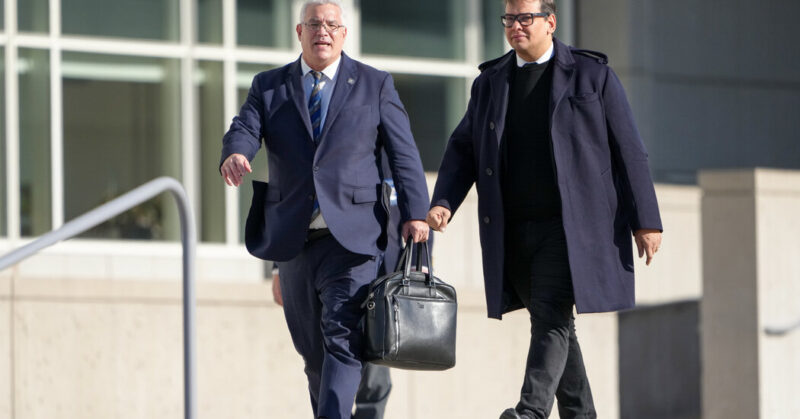George Santos, Clinging to His 15 Minutes

Good morning. It’s Tuesday. Today we’ll find out about where former Representative George Santos is expected this morning. We’ll also get details on a city plan to eliminate up to $2 billion in unpaid medical debt for as many as 500,000 people.
“I’m still here — I’m still relevant,” former Representative George Santos told the television host Piers Morgan last week. “People still want to talk to me. People still want to hear what I have to say.”
This morning, the people who will want to hear from Santos are federal prosecutors and a judge. Doing the talking for him will be Joseph Murray, who has represented Santos in previous court appearances, and two new lawyers.
The occasion is a status conference Judge Joanna Seybert called to discuss the case, in which Santos faces 23 felony charges, ranging from identity theft to wire fraud. Last month the prosecutors disclosed in a court filing that they were in the early stages of negotiating a plea agreement “with the goal of resolving this matter without the need for a trial.” Santos has pleaded not guilty.
The two sides have proposed an agenda for the status conference, including a timetable for pretrial motions. Prosecutors said on Monday that they were prepared to give Santos’s lawyers about 6,000 pages of documents in addition to four batches of material they turned over last year.
Unlike some disgraced former officials, Santos has not gone into hiding in the seven weeks since he was expelled from the House. While he remains a punchline on late-night talk shows, he has recorded personalized videos through the platform Cameo.
Santos read messages requested by Cameo users for a fee — $75 at first, but as he became a breakout attraction, the price rose to $400, then $500 and even, according to one comment on Cameo, $800. Santos said that he had earned the equivalent of his $174,000 congressional salary in the first week after he was kicked out of the House, a claim he assured a television interviewer was “actually factual.”
Our critic Amanda Hess wrote that Santos “plods through condolences and congratulations” in videos that she called “tedious and flat,” but Santos’s efforts got attention. The late-night host Jimmy Kimmel pranked him, making up outlandish requests for Santos to read without saying they were from him. Santos dutifully read them.
With surge pricing, what goes up can come down, and Santos’s fee on Cameo has slipped to $350. But he keeps the customers satisfied: 94 percent of his ratings are in the five-star category.
Still, fame is fleeting, and Santos has an innate understanding of what might well be called the attention economy. He may have decided that he would have more luck stretching his 15 minutes if he pivoted back to what had worked for him in the past: politics.
Last week he posted on X about the caucuses in Iowa. Over the weekend he referred to Representative Anthony D’Esposito as a “sanctimonious schlub.” D’Esposito is a fellow Long Island Republican who, with Representative Nick LaLota, led the push to kick Santos out of the House.
Santos also attended, and posted from, a session on the Upper East Side that was organized by the right-wing advocacy group Moms for Liberty. “All love in the room,” he wrote on X, “and I can’t wait to have a fantastic evening strategizing to save our kids from indoctrination and put an end to WOKE!” Mother Jones reported that he had “slipped out of the room” after about 45 minutes, saying he had a dinner engagement.
In the appearance with Morgan, who tried to press Santos on why he had lied “so brazenly so often,” Santos said he was “not at liberty of speaking on certain things.” He mentioned contractual obligations for a documentary by a filmmaker who is paying Santos an “archival materials fee” for things like photos and videos.
And, referring to the Justice Department, Santos added, “I have an entire process with the D.O.J. ahead of me, so it would be stupid, it would be ill-advisable and I wouldn’t do myself any favors.” He could face 22 years in federal prison.
Weather
A chance of freezing rain during the day, with a chance of rain continuing into the evening. Expect mild winds throughout the day, with temperatures in the mid-30s.
ALTERNATE-SIDE PARKING
In effect until Feb. 9 (Lunar New Year’s Eve).
The latest New York news
A plan to wipe out medical debt for 500,000 New Yorkers
Mayor Eric Adams announced that the city would spend $18 million to buy up and then erase unpaid medical debt in a program that officials hope will benefit as many as 500,000 people.
The mayor outlined a partnership with a nonprofit organization that purchases unpaid patient debt from hospitals at deep discounts and then forgives the balances. Hospital systems and commercial debt buyers are often willing to sell medical debt for pennies on the dollar. The city’s $18 million could do away with more than $2 billion in unpaid medical bills, city officials said.
“Not only do you hold your breath when you go into a hospital or a doctor’s office and wait for a diagnosis,” Adams said, “you continue to hold your breath when you see the bill and what it costs, particularly for low-income New Yorkers.”
The effort comes not quite six weeks after Gov. Kathy Hochul signed legislation that prevents health care professionals and ambulance services from reporting someone’s medical debt to credit agencies.
Officials said the city would work with RIP Medical Debt, which says it has relieved more than $10.4 billion medical debt for more than 7.1 million families and individuals in the last nine years.
New Yorkers with past-due balances for hospital care will not need to apply for the program — RIP will choose the people whose debts will be eliminated. Daniel Lempert, a spokesman for RIP Medical Debt, said it looks for patients whose unpaid medical bills are at least 5 percent of their annual household income or patients in households with an income under four times the federal poverty line — which is $31,200 for a family of four.
Some nonprofit hospital systems in New York sue patients over unpaid medical bills. The mayor called medical debt “the No. 1 cause of bankruptcy” because “it impacts your credit scores, it impacts your ability to purchase a home” — and even the chances of getting a job if prospective employers check applicants’ credit scores.
METROPOLITAN diary
Angel
Dear Diary:
I lived on the Upper West Side in the 1980s. I worked at home, and alternate-side parking gave my day structure. Every other day, I would get up, double park my 1974 Dodge Dart by 9 a.m., return home and then come back and move it to a legal spot.
One Thursday, I got up at 9 a.m. and could not find my car keys or remember where I’d parked the Dart. Rushing out to the street, I saw that the cars on the block that hadn’t been moved already had tickets. Mine wasn’t one of them.
Walking past the double-parked cars across the street, I saw the Dart. I was confused. When had I moved it? I still didn’t have my keys. The car was locked, and they weren’t in it.
I noticed a note on the windshield: See Angel the mechanic at the Broadway Hotel.
At the hotel, I found Angel among a group of men talking outside. He said he had seen me in the neighborhood and had noticed two days earlier that I left my keys in the ignition.
Not wanting the car to be stolen, he had taken the keys and left the note. When I was late coming out that morning, he had moved the car so it wouldn’t get a ticket.
— Bob Botfeld
Illustrated by Agnes Lee. Send submissions here and read more Metropolitan Diary here.
Glad we could get together here. See you tomorrow. — J.B.
P.S. Here’s today’s Mini Crossword and Spelling Bee. You can find all our puzzles here.
Geordon Wollner, Grace Ashford and Ed Shanahan contributed to New York Today. You can reach the team at nytoday@nytimes.com.








